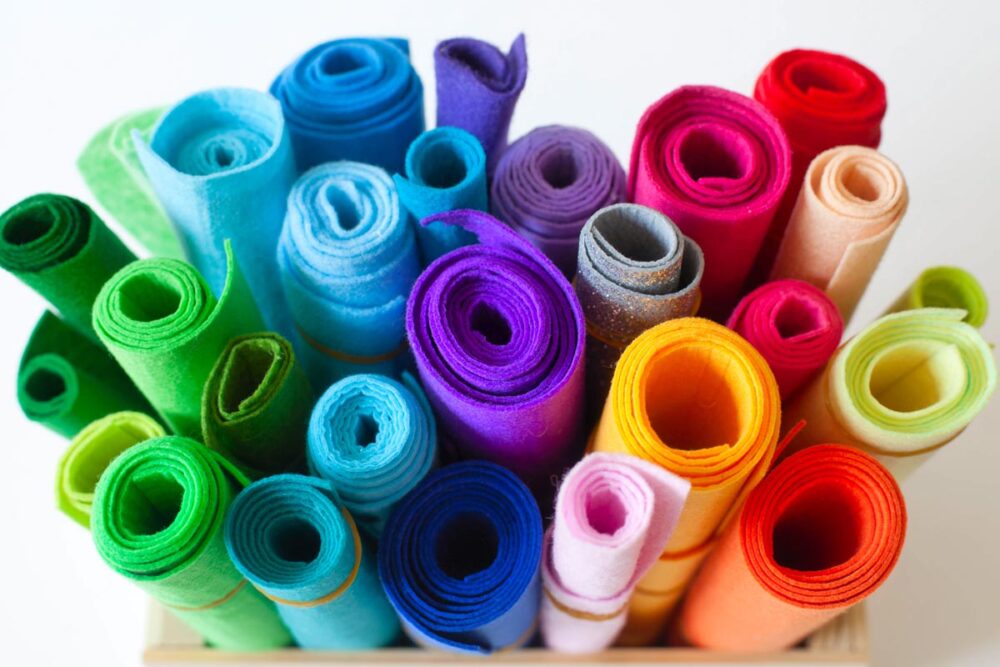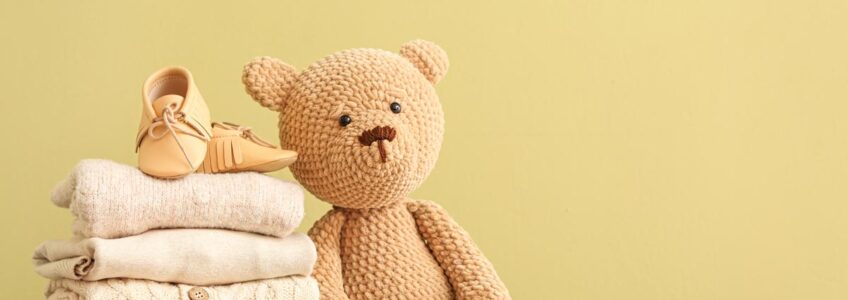The latest novelty by Cimmino is the Baltimore Digital Cotton fabric. It is a 100% cotton canvas, obtained by a process of sanforization, soft hand and light weight, printed in many patterns.
(more…)Terry fabric: characteristics and types
Terry cloth is one of the most widely used household linen items. It’s the kind of material that generally makes bathrobes, towels and towels that we use after the bath or shower, so it’s basically meant to dry. In fact, the terry cloth is called so precisely for its ability to absorb large amounts of water.
(more…)Tulle Velo Lux: one of the best fabrics for dance and show
Among the latest novelties by Cimmino, we cannot fail to mention the Tulle Velo Lux: it is a very light and transparent 100% polyamide fabric, with a semi-rigid hand and a brilliant appearance, ideal for making stage clothes and costumes for the world of dance and entertainment.
(more…)The best fabrics for childhood
Dressing a child is never easy, for this reason Manifattura Foderami Cimmino helps you choose the best fabrics for children, thanks to a wide and increasingly updated assortment.
Cimmino offers you fabrics that reflect the atmosphere of fairy tales, printed and colored, which lead your child to immerse themselves in new and fantastic worlds from an early age.
Miranda fabric: different patterns and colors to decorate home
Miranda, a loneta fabric in polycotone and rotary printing, is the latest novelty in the Home Decor category by Cimmino.
(more…)The thousand uses of felt, versatile and practical fabric
Felt is a fabric made of animal hair, usually it is carded sheep’s wool, but it can be made of any other type of hair. Let’s discover, together with Manifattura Foderami Cimmino, the characteristics of felt and the different ways to use it!
Felt cannot be defined as fabric, because it is produced by felting of the fibers, in fact it is defined as a non-woven fabric (TNT). Therefore, the spinning, warping or weaving process does not take place. The fibres are wet with warm water, soaked with soap, beaten, rubbed and pressed until they are felted, by mechanical and chemical processes.
Thefelting is progressive and irreversible and makes this compact layer particularly warm and waterproof. The traditional felt is the color of the hair used, but you can also produce colored wool using specially dyed wool.

This material, whose best known use is that related to theproduction of hats, is actually used since ancient times in many crafts and not only. It is said to be the first man-made fabric. Its origins date back to the third millennium B.C. and was used by the Greeks and Romans to make clothes, headdresses and cloaks. In fact, the name probably derives from the city of Feltre, the town of the Roman Empire that was famous for the fulling of wool and the trade of felted fabrics. The sheep, a domesticated animal already in prehistoric times, has a fleece composed of both wool and giarre, that is, robust and bristly hairs that serve the animal to protect itself.
Felting can also take place through the needle-punching process, a particular vertical movement of the needles that makes the fibers more compact. Its characteristics are: water repellency, resistance to both lower and higher temperatures and softness to the touch. The overlapping of several layers of veil will give this fabric a certain consistency that can be increased with resination or thermo-fixation processes, typical of the textile industry. Artisanal or industrial, the felting process affects the flakes on the surface of the fiber.
In the 19th century, “wearing felt” was equivalent to “wearing a hat”; nowadays, on the other hand, carpets, bags, slippers, blankets and much more are also produced with felt. Let’s find out in detail all the different uses of felt!

What can I do with felt?
To create objects and decorations with feltyou need very few things, combined with a dose of imagination, patience and a pinch of manual skill. It also depends on what you do.
Depending on the case, tools will be useful to cut and work felt, such as a pair of scissors, hot glue or the traditional “needle and thread”, and possibly paper patterns, as in all sewing creations. If you want to make felt cushions or dolls, you also need padding, perhaps with wadding.
Manifattura Foderami Cimmino has selected some types of felt that find different uses: from the creation of simple covers to the packaging of costumes for various events, such as Christmas and Carnival, through the creation of accessories and decorations. Let’s see together what they are!
Feltro Sottocollo
This type of fabric is mainly used forlining and interfacing. The interfoder helps to control the movements of the outer fabric, protecting it during the washing and ironing cycles, while the lining helps to improve shape and fit. Specifically, the fabric in question is nothing more than a wool and viscose blend undercoat support that has the ability to give the collar shape and support.


Colored Felt
This type of felt, as the name suggests, is available in many varieties of color: lemon yellow, yellow ocher, orange, forest green, light blue, white, cream, pink, red, brown, blue, acid green, black, beige, gray, blue, ice, smoke and burgundy. The wide range of colors lends itself well to hobby and craft work, for the realization of patchwork and decorations in general.
The versatility of this felt makes it particularly suitable also in packaging clothes for special events, Carnival and Cosplay.
Make Glitter Extra Cloth
It is a glittered felt, suitable for various types of creative sewing, especially for the realization of Christmas and Easter crafts, events and private parties, Carnival dresses, decorations, puppets, accessories and various applications. This is also available in different colors: black, red, blue, pink, green and white.


Cloth Make Glitter
Glittered felt, used for various types of creative sewing, Christmas and Easter crafts, events and parties, Carnival dresses, decorations, accessories and various applications. On the 100% Polyester felt cloth, available in different colors, glitter silver stars appear.
Panno Best
It is a very thin felt in solid color, suitable for various types of creative sewing. Like the Glitter Make Cloth and the Extra Glitter Make Cloth, it lends itself to various interpretations and processes.


Color Felt
A felt with a wide range of solid colors (among those already mentioned above), ideal for hobbies, crafts, patchwork and decorations in general. It can also be used to make small accessories, such as bags and cases.
What’s the difference between felt and pannolenci?
Many people wonder what is the difference between felt and pannolenci. In a strictly technical sense we can say none, as both are obtained by felting the raw sheep’s wool, although in recent times these fabrics are also processed from other fibers.
Compared to felt, pannolenci has a much more recent history: it was invented in 1919 by the company Lenci, specialized in games for children, who made dolls with cloth clothes.
The only difference between the two is in the thickness: higher for the felt and much thinner for the pannolenci. The stiffness of the felt allows for solid structures such as bags and hats, while the pannolenci is softer and malleable. The latter lends itself well, for example, in making clothes for dolls, in making dolls or decorations to enrich our products.
Are you ready to test your creativity? Discover now the proposals of felt fabric by Manifattura Foderami Cimmino and choose this versatile and surprising material!
Fashion trends 2022: the news from Milan Fashion Week
The Milan Fashion Week has opened its doors to the spring summer 2022and fall winter 2022-2023 trends. Let’s find out, together with Manifattura Foderami Cimmino, what will be the trends to follow, in terms of clothing, for next season!
(more…)Cloth Sublimatik: novelties for hobbying and decorations
Cimmino’s catalogue presents a new fabric, Panno Sublimatik: a lightweight needle punch with patterned prints, used for creative hobbies, patchwork and decorations, as well as the creation of small accessories such as bags and cases. Needle punched fabric is a type of felt formed with very thin threads pressed together, composed mainly of synthetic fibers (in this case 100% polyester) and obtained through a special mechanical needle treatment. It is therefore a non-woven fabric (TNT), that is, with a texture similar to a fabric but obtained with processes other than weaving (weft and warp crossing by loom) and knitting. Its characteristics are: resistance to both lower and higher temperatures and a particular softness to the touch. This type of fabric is safe and environmentally friendly, so ideal for making children’s creations. For example, you can make beautiful dream catchers for the fabric cradle. Each fabric does not fade and is easy to work with.

How to make patchwork accessories with the Sublimatik Cloth
Sewing is a creative art and one of its greatest expressions is reflected in patchwork, an American technique that consists in the combination of multiple fabrics of different textures and colors. Among the various styles of the patchwork technique there is the biscuit, also called “puff patchwork”, with which to make soft creations such as pillows. Everything you need can be summarized in: a sewing machine, pins, scissors, a neutral fabric of white color, four or more fabrics of different patterns and colors, cotton wool for stuffing.
Sublimatik cloth can be ordered in the colors of pink, light blue, lilac, beige and yellow. The available patterns are particularly suitable for children: we have patterns in hearts, polka dots, with stars and bows.
The colored fabric should be cut into squares of equal size, depending on your taste: they can be 10×10 cm or 12×12 cm. Pins should be placed at the upper corners of the colored fabric and at the lower corners of the white fabric: form small folds in the middle of each of the 3 sides on 4 of each square and Fermatele with a pin. Sew these 3 sides with the sewing machine making sure to leave at least 3 mm as the seam allowance. Insert the wadding in the side of the square left free and sew it also.
Move it: the biggest event dedicated to the world of dance
In 2006, a group of dancers gathered to celebrate their love of dance, creating a community of dancers who would support, encourage, and inspire each other.
From 11 to 13 March 2022, the 15th edition of MOVE IT was held, the largest dance event in the world, which was also attended by the company Cimmino with its fabrics for dance and entertainment.
H+H Cologne 2022: the international DIY and hobby fair
The city of Cologne is the world’s largest showcase of tools, accessories and useful supplies for hobbies and crafts. With over 3,500 attendees from more than 70 countries, the h+h tradefair was also successful in digital format. About 100 companies from 29 countries participated as exhibitors at the last edition. A real boom of DIY: the craft industry has recorded record sales and is preparing to reach higher and higher peaks.
(more…)











